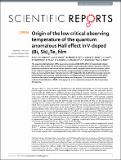| dc.contributor.author | Li, W. | |
| dc.contributor.author | Claassen, M. | |
| dc.contributor.author | Moritz, B. | |
| dc.contributor.author | Jia, T. | |
| dc.contributor.author | Zhang, C. | |
| dc.contributor.author | Rebec, S. | |
| dc.contributor.author | Lee, J. J. | |
| dc.contributor.author | Hashimoto, M. | |
| dc.contributor.author | Lu, D.-H. | |
| dc.contributor.author | Moore, R. G. | |
| dc.contributor.author | Devereaux, T. P. | |
| dc.contributor.author | Shen, Z.-X. | |
| dc.contributor.author | Chang, Cui-zu | |
| dc.contributor.author | Moodera, Jagadeesh | |
| dc.date.accessioned | 2017-04-26T18:28:00Z | |
| dc.date.available | 2017-04-26T18:28:00Z | |
| dc.date.issued | 2016-09 | |
| dc.date.submitted | 2016-05 | |
| dc.identifier.issn | 2045-2322 | |
| dc.identifier.uri | http://hdl.handle.net/1721.1/108423 | |
| dc.description.abstract | The experimental realization of the quantum anomalous Hall (QAH) effect in magnetically-doped (Bi, Sb)[subscript 2]Te[subscript 3] films stands out as a landmark of modern condensed matter physics. However, ultra-low temperatures down to few tens of mK are needed to reach the quantization of Hall resistance, which is two orders of magnitude lower than the ferromagnetic phase transition temperature of the films. Here, we systematically study the band structure of V-doped (Bi, Sb)[subscript 2]Te[subscript 3] thin films by angle-resolved photoemission spectroscopy (ARPES) and show unambiguously that the bulk valence band (BVB) maximum lies higher in energy than the surface state Dirac point. Our results demonstrate clear evidence that localization of BVB carriers plays an active role and can account for the temperature discrepancy. | en_US |
| dc.language.iso | en_US | |
| dc.publisher | Nature Publishing Group | en_US |
| dc.relation.isversionof | http://dx.doi.org/10.1038/srep32732 | en_US |
| dc.rights | Creative Commons Attribution 4.0 International License | en_US |
| dc.rights.uri | http://creativecommons.org/licenses/by/4.0/ | en_US |
| dc.source | Nature | en_US |
| dc.title | Origin of the low critical observing temperature of the quantum anomalous Hall effect in V-doped (Bi, Sb)[subscript 2]Te[subscript 3] film | en_US |
| dc.title.alternative | Origin of the low critical observing temperature of the quantum anomalous Hall effect in V-doped (Bi, Sb)2Te3 film | en_US |
| dc.type | Article | en_US |
| dc.identifier.citation | Li, W. et al. “Origin of the Low Critical Observing Temperature of the Quantum Anomalous Hall Effect in V-Doped (Bi, Sb)[subscript 2]Te[subscript 3] Film.” Scientific Reports 6.1 (2016): n. pag. | en_US |
| dc.contributor.department | Massachusetts Institute of Technology. Department of Physics | en_US |
| dc.contributor.department | Francis Bitter Magnet Laboratory (Massachusetts Institute of Technology) | en_US |
| dc.contributor.mitauthor | Chang, Cui-zu | |
| dc.contributor.mitauthor | Moodera, Jagadeesh | |
| dc.relation.journal | Scientific Reports | en_US |
| dc.eprint.version | Final published version | en_US |
| dc.type.uri | http://purl.org/eprint/type/JournalArticle | en_US |
| eprint.status | http://purl.org/eprint/status/PeerReviewed | en_US |
| dspace.orderedauthors | Li, W.; Claassen, M.; Chang, Cui-Zu; Moritz, B.; Jia, T.; Zhang, C.; Rebec, S.; Lee, J. J.; Hashimoto, M.; Lu, D.-H.; Moore, R. G.; Moodera, J. S.; Devereaux, T. P.; Shen, Z.-X. | en_US |
| dspace.embargo.terms | N | en_US |
| dc.identifier.orcid | https://orcid.org/0000-0001-7413-5715 | |
| dc.identifier.orcid | https://orcid.org/0000-0002-2480-1211 | |
| mit.license | PUBLISHER_CC | en_US |
